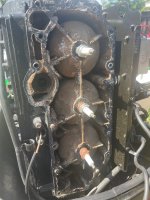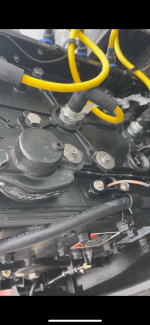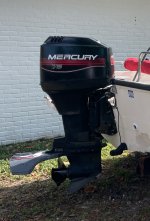dustychops
Cadet
- Joined
- May 8, 2023
- Messages
- 11
Hi everyone,
I’m hoping to get some advice on an issue I’ve been dealing with for the past two years on my 1998 15’ Boston Whaler Dauntless, powered by a 1998 Mercury 75 HP 2-stroke (ELPTO, Serial OG622***). Here’s a detailed breakdown of the problem and what I’ve tried so far:
The discrepancies in the firing intervals on my engine suggest a potential electrical issue. However, I’m not certain if this is due to the camera's limitations or an actual problem with the spark.
Thanks in advance, and feel free to ask if I’ve left out any details.
I’m hoping to get some advice on an issue I’ve been dealing with for the past two years on my 1998 15’ Boston Whaler Dauntless, powered by a 1998 Mercury 75 HP 2-stroke (ELPTO, Serial OG622***). Here’s a detailed breakdown of the problem and what I’ve tried so far:
Initial Condition:
- When I bought the boat two years ago, it would only go up to 22 MPH, and the RPM gauge was broken.
- The first thing I did was replace the RPM gauge, rebuild the fuel pump, change the spark plugs, and replace the primary and secondary fuel filters.
- After these changes, the boat could reach 4200 RPMs and 30 MPH. However, on my next outing, it dropped to 3500 RPMs and 25 MPH.
Steps Taken to Fix the Problem:
- Carburetor Rebuild: I rebuilt all three carburetors, but this did not improve the RPMs.
- Fuel System Overhaul: Replaced the primer bulb, all fuel lines (tank to carburetors), and fittings. Still no improvement.
- Propeller Change: Swapped the heavy stainless steel 20P prop for a lighter aluminum 17P Black Max prop, which improved the hole shot but didn’t affect RPMs.
- Timing Adjustment: Set the WOT timing to 20 degrees BTDC, per the service manual. I experimented with slight adjustments but found no improvement.
- Compression Test: All three cylinders showed 120 PSI, which I’ve heard is acceptable for a 2-stroke. The manual, however, states that anything below 120 PSI could indicate significant engine wear.
- Ignition Coil Replacement: Replaced all three ignition coils, but there was no change in performance.
Notable Event:
One day, while leaving an island, the boat unexpectedly gained and lost power multiple times at full throttle, as if a switch was being flipped on and off. This made me suspect an electrical issue or perhaps a cylinder cutting out.Diagnostics and Testing:
- Comparison Test: My neighbor has a 2004 16’ Key West with an identical 2004 Mercury 75 HP 2-stroke. His boat reaches 5250 RPMs and 38 MPH. This ruled out any fundamental issue with the propeller or engine type.
- Stator Resistance Test: I used a multimeter to check the stator (red type with two yellow wires for charging and green/white and white/green wires for ignition). All readings were within the manual’s specifications.
- Advice from Local Dealer: A Mercury parts dealer suggested that Ohm readings might not tell the whole story, and recommended a DVA voltage test for a more accurate diagnosis. He also ruled out reed valves as the likely cause, noting that engines with bad reed valves often idle poorly but still reach high RPMs.
- Spark Test: I used an inline spark plug tester to check each cylinder and recorded the spark consistency using my iPhone 12 at 240 FPS slow-motion. The results showed inconsistent firing intervals at idle (≈1500 RPMs). Below is the data I gathered:
My Engine (1998 Mercury 75 HP, 3500 RPM max):
Sparks Fired (seconds) - Time Between (seconds) @1500 RPM
4.00 - 0.08
4.08 - 0.04
4.12 - 0.08
4.20 - 0.03
4.23 - 0.05
4.28 - 0.03
4.31 - 0.04
4.35 - 0.04
4.39 - 0.11
...
Neighbor’s Engine (2004 Mercury 75 HP, 5250 RPM Max):
Sparks Fired (seconds) - Time Between (seconds) @1500 RPM
4.01 - 0.04
4.05 - 0.05
4.10 - 0.04
4.14 - 0.04
4.18 - 0.04
The discrepancies in the firing intervals on my engine suggest a potential electrical issue. However, I’m not certain if this is due to the camera's limitations or an actual problem with the spark.
Next Steps:
I purchased a DVA adapter for my multimeter to perform stator output tests and trigger tests while the engine is idling. I’ve also made a makeshift harness to help with this testing, using a diagram I found online. I’m trying to avoid spending $400 on a new stator unless I can confirm it’s the problem.Question:
Based on this information, do you think the stator is the culprit, or could there be another underlying issue? I appreciate any insights or suggestions on what to check next.Thanks in advance, and feel free to ask if I’ve left out any details.























